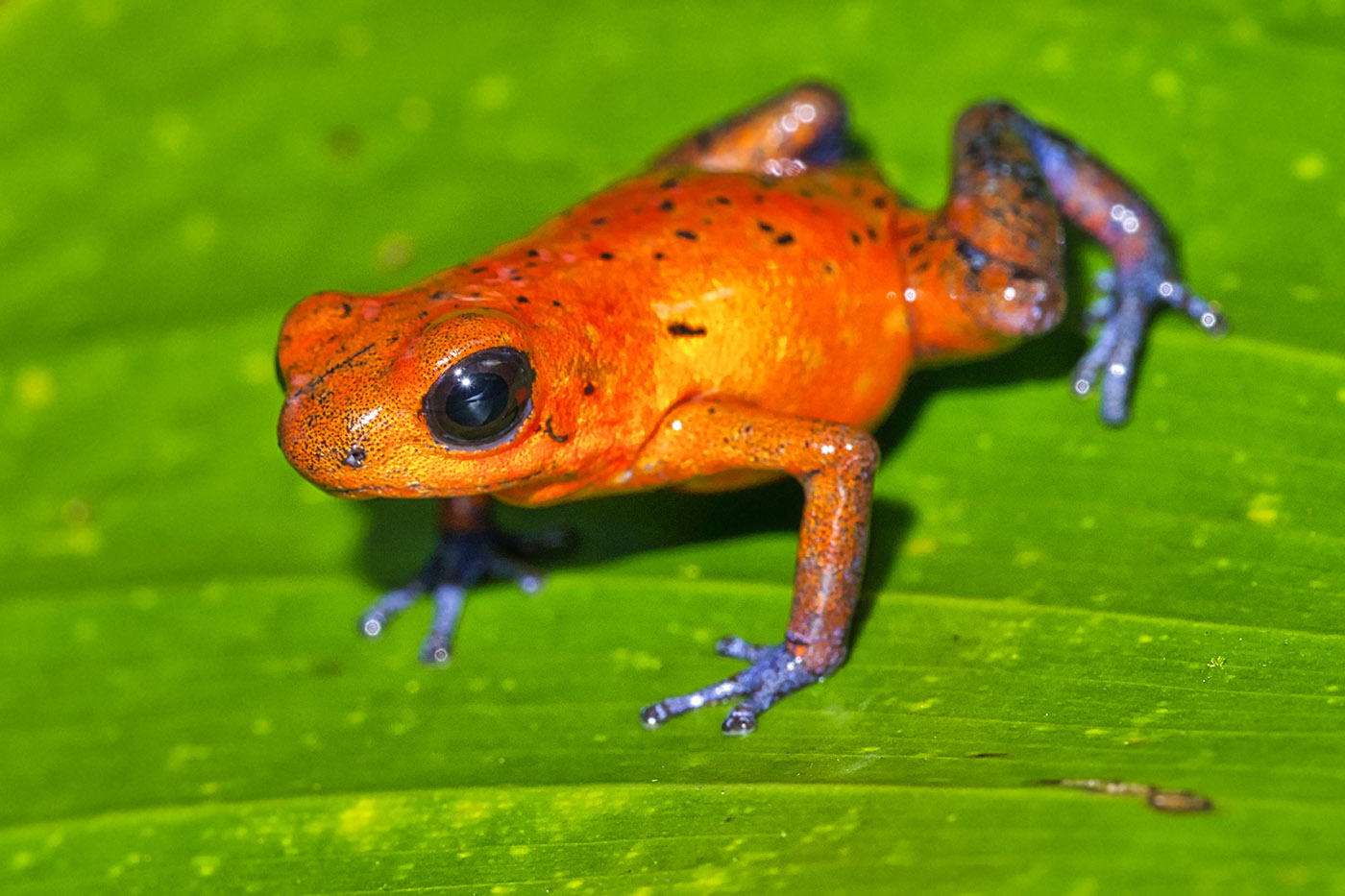Enjoy this 2014 SAVE THE FROGS! Belize Ecotour summary by Michael Starkey…
WOW! What a trip! The SAVE THE FROGS! Ecotour to Belize was a blast! From June 19th to the 28th, ten frog-saving supporters trekked through rainforests, hiked through pine savannah, relaxed on white, sandy beaches, and found lots and lots of beautiful frogs! See the adventure for yourself and check out these amazing photos from the 2014 SAVE THE FROGS! Eco-tour to Belize.
On the 19th of June, the SAVE THE FROGS! Eco-tour landed in beautiful Belize. After such a long day of traveling, we arrived at our first destination: The Tropical Education Center (TEC)!
After settling in, we set out to find some frogs. It was the beginning of the wet season in Belize and the frogs were out! The first frog we found was a Sabinal Frog, Leptodactylus melanonotus! Isn’t it gorgeous?
Here’s SAVE THE FROGS! Education Coordinator Kathlyn Franco with a beautiful Veined Tree Frog, Trachycephalus venulosus.
What an awesome frog!
Besides frogs, we found some toads too! Who couldn’t love the charming face of a Gulf Coast Toad, Incilius valliceps?
Snakes alive! We found an adorable little Black Stripe Snake, Coniophanes imperialis.
While staying at the TEC, we took a day to experience the incredible archaeological site Xunantunich! Located just outside of San Ignacio, this city is thousands of years old. We were also quite privileged to receive a guided tour of the local plants and their uses as we explored the ancient Mayan city.
The SAVE THE FROGS! Eco-tour group members say “HI!” from the historic Xunantunich Mayan archaeological site.
The SAVE THE FROGS! Belize Eco-tour left the Tropical Education Center and traveled far south to the small, Mayan town of Blue Creek. Situated in pristine, old-growth rainforest, Blue Creek is a haven for wildlife and the diversity of flora and fauna is amazing!
At Blue Creek there are so many activities to experience. We were guided through the forest by an extremely knowledgeable Mayan ethnobotanist and we learned how the forest provides so many uses for the Mayan people. We also trekked up mountains, hiked through the rainforest, forged rivers, and explored intricate cave systems.
It is a truly beautiful area to visit and explore.
We spent many hours of the day hiking through the myriad of trails that pass through the rainforest.
The water level in the creek, which was acting more like a raging river, was quite high! It was quite the experience to cross together as a group!
If we were not hiking trails or fording streams, then we were climbing! While being somewhat difficult, all members of the group were able to climb up root-covered rock walls to make it to the entrance of the Blue Creek Cave.
Blue Creek Cave is an incredible sight. The mouth of the cave is absolutely breathtaking!
One day we explored the inside of Blue Creek Cave!
Getting there was quite an experience, but it was well worth the hike!
We discovered many interesting creatures that called the cave home, included this Tailless whip scorpions (often called whip spiders), but they are scientifically referred to as amblypigids. They might look a bit scary, but they are totally harmless.
One morning we took a few hours to walk with a local guide and ethnobotanist.
The guide led us all around the forest and taught us how they used plants in the forest for their food, making their homes, or even for their medicine.
Would you drink from this vine? Well the water vine is a survival item for the Maya as the water contained in the vine is completely safe to drink.
After a day of hiking through the forest, it was great to cool off in Blue Creek! Rain or not, it was still a refreshing experience.
The dock at Blue Creek is a great place to relax, bird watch, and enjoy a nice, cold beer.
From Black Hawks soaring above our heads to coming face to face with the elusive water possum, the wildlife sightings were phenomenal! The best part though? The frogs! This Mexican Treefrog, Smilisca baudinii, was contently lounging about by a light looking for insects to eat.
The diversity of amphibian life is quite high in Blue Creek because of the substantial rain that falls each wet season. During our stay it was the beginning of the wet season in Belize and the frogs were out! Each night we went out looking for frogs we were never disappointed.
Yellow Treefrog, Dendropsophus microcephalus
Yellow Treefrog, Dendropsophus microcephalus
On our last night at Blue Creek we found so many Marine Toads!
That’s a lot of toads! Yikes!
After a few photos, we set them on their way. These toads are essential for controlling pest species in Belize, like cockroaches, mice, snakes, and even scorpions! For the most part, scorpions are harmless to humans, but if one stings you… it’s going to hurt!
The trip continued to get better as we headed north toward the Toucan Ridge Ecology and Education Society (TREES)! Home of the endemic Maya Mountain Frog, TREES is located on 200 acres of prime amphibian habitat and it borders the Sibun Forest Reserve.
The facilities are quite nice and the view from your cabana is even better.
TREES not only offers amazing opportunities to the see the forest, but the amenities are also excellent for birding or chilling out in the hammocks.
The swimming is great too!
There is so much to see and do at TREES, but we were there for frogs… and frogs we found!
At night we set off into the forest and hoped to find some fabulous amphibians.
It was not long before were found the endemic and threatened Mayan Mountain Frog, Rana (Lithobates) juliani. This species is unfortunately becoming quite rare in Belize, so it is a treat to be able to see a healthy population at TREES!
This is a juvenile Mayan Mountain Frog, Rana (Lithobates) juliani
We found a Vaillant Frog, the largest species of frog in Belize. Look at that beautiful green head!
We also found some amazing species that live on the forest floor! This is the endangered Rain Frog, Craugastor sandersoni. This species is heavily impacted by habitat destruction and pesticides.
We also found the threatened Blue-spotted Treefrog, Smilisca cyanosticta. Can you guess why it is called the Blue-spotted Treefrog?
We also found some very cool reptiles, like this cryptic Helmeted Iguana, Corytophanes cristatus.
This species is very hard to find, so it was a joy to see them up close and personal.
After a froggy week in the jungle it was time to dry out and head to the island! Our group spent the remainder of the trip at South Water Caye, which is a 14 acre island that is just a 45 minute boat ride east of Dangriga.
This was a great place to relax, snorkel, and bird watch! We were taken to some excellent snorkel sights, but along the way we had to check out the Frigate bird and Brown Booby colony!
Sadly there were no frogs on the island, we did find this pretty amazing endemic species of gecko!
After a relaxing few days, the group packed up and went home. What a trip!
Want to experience a SAVE THE FROGS! Ecotour adventure first hand? Then send an email of interest to ecotours@savethefrogs.com — we’d love to have you join us frogging!



